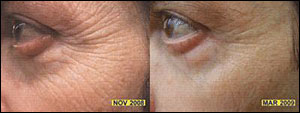
LEDs, Tea Better Than Botox?
ULM, Germany, Sept. 10, 2009 – A new noninvasive technique for treating facial wrinkles by combining high-intensity LED light and a lotion made of green tea extract could become an alternative to Botox and cosmetic surgery.
The new treatment works 10 times faster than a similar antiwrinkle treatment that uses LEDs alone, said researchers at the Institute of Micro and Nanomaterials, Central Institute of Biomedical Engineering, at the University of Ulm. Their study is scheduled for the Oct. 7 issue of the American Chemical Society’s Crystal Growth & Design journal.

A combination of LED light exposure and green tea extract significantly reduces skin wrinkles (right image) when compared to treatment with LED light alone, scientists are reporting. (Image courtesy Crystal Growth & Design)
Light therapy, or phototherapy, has been used for more than 40 years to help heal wounds. Last fall, scientists Andrei P. Sommer and Dan Zhu showed that using high-intensity LEDs, similar to those used in automotive taillights and computers, could help reduce skin wrinkles when applied daily for several months. But exposure to intense LED light is also involved in generating high levels of reactive oxygen species as by-products that can potentially damage cells. To combat that effect, the researchers combined the LED with a potent antioxidant in green tea extract called epigallocatechin gallate.
They applied a daily combination of LED light and green tea extract to the facial wrinkles of a human volunteer for one month. The combination treatment resulted in smoother skin, including “less pronounced wrinkle levels, shorter wrinkle valleys and juvenile complexion,” the scientists said. The treatment showed promising results in only one-tenth of the time it took for LED therapy alone to reduce wrinkles. The study could form the basis of “an effective facial rejuvenation program” and lead to a new understanding of the effect of reactive oxygen species on cellular aging, they noted.
For more information, visit: www.acs.org
Published: September 2009